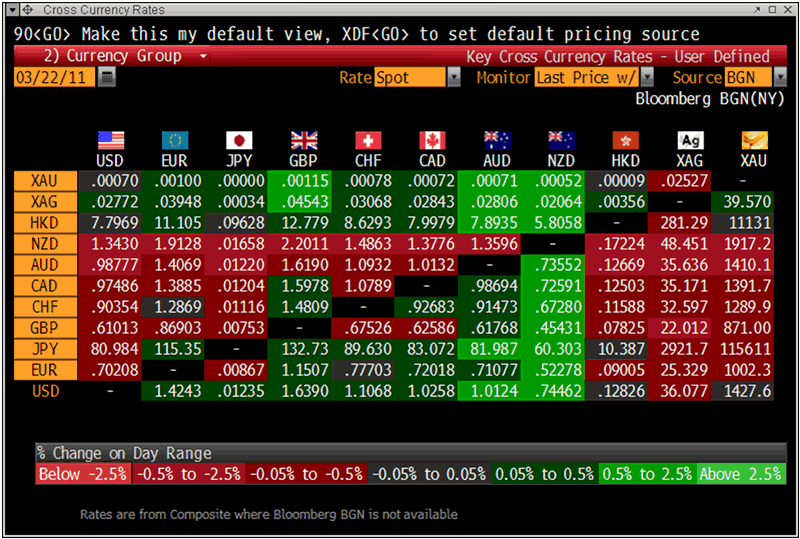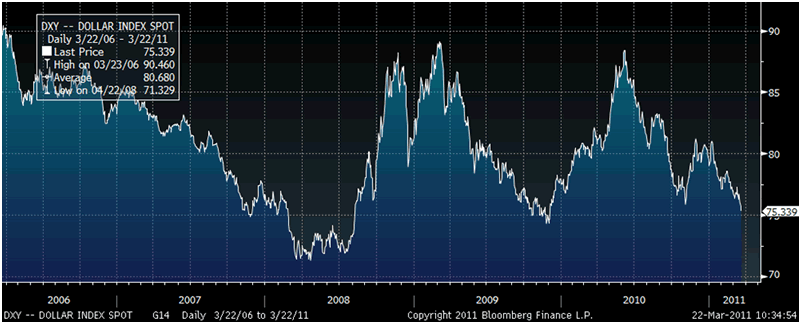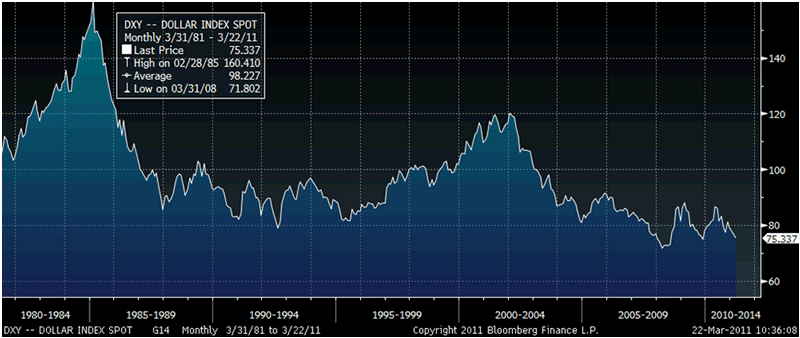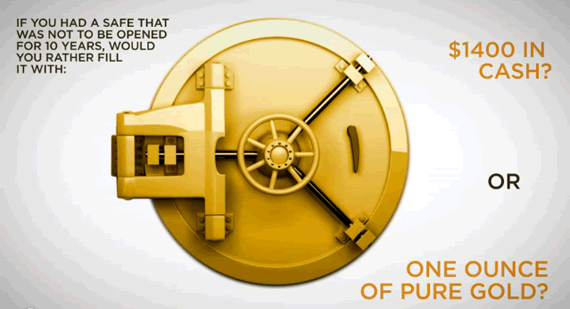Gold Just 1% From Record Nominal High of $1,444/oz – Risk of Dollar Crisis Increases By Day
Commodities / Gold and Silver 2011 Mar 22, 2011 - 07:56 AM GMTBy: GoldCore

 The U.S. dollar and yen are under pressure again today while gold and silver have taken breathers after yesterday’s gains (see table). Rather than gold and silver rising in price, we are seeing the continual devaluation of the U.S. dollar, the yen and all fiat currencies and thus their prices falling against the precious metals.
The U.S. dollar and yen are under pressure again today while gold and silver have taken breathers after yesterday’s gains (see table). Rather than gold and silver rising in price, we are seeing the continual devaluation of the U.S. dollar, the yen and all fiat currencies and thus their prices falling against the precious metals.

Incredibly, the dollar has lost 7.5% of its value in less than 3 months (since January 7th 2011) and more than 17% in just 8 months since August 2010. Hence the nominal record highs in gold and silver. The volatility and sharp falls in the dollar are leading to deepening inflation throughout the world (as seen in the UK inflation rate of 4.4% today).

Thus, the dollar’s safe haven status is being increasingly questioned. Many market participants are worried because the dollar continues to fall despite the real risks of a recurrence of the Eurozone sovereign debt crisis, a wider military conflict in North Africa and the Middle East and a nuclear catastrophe in Japan.
As the world gradually rejects the dollar as the reserve currency of the world there is the real risk of a dollar crisis. Should the dollar fall to below 71 on the US Dollar Index (see charts), there could be a wholesale liquidation of the dollar. This could feed on itself and lead to a currency crash as was seen with the British pound in 1992.
The monetary and fiscal position of the U.S. today is many times worse than that of the UK in 1992 which makes this risk very real.

George Soros was widely credited with being the man who “broke the Bank of England”. An array of hedge funds, sovereign wealth funds and central banks could very easily “break the Federal Reserve”. It may not necessarily be by design rather it may come about due to forced selling in order to protect the massive dollar holdings held by many powerful players.
A dollar crisis would not be beneficial to the euro, pound or other fiat currencies as they too would likely come under selling pressure due to competitive currency devaluations and debasement.
International equities would likely do well as investors hedge their currency risk. The very small gold and silver bullion markets would see an unprecedented volume of capital try to enter the market to accumulate bullion which would see prices rise dramatically.
Only much higher interest rates and a real return on deposits and interest bearing debt over inflation will prevent massive inflation. But the U.S. and the western world saturated in debt may not be able to cope with even slightly higher rates.
NEWS
(Bloomberg) -- Gold Outlook Is ‘Bullish’ on Investment Demand, GFMS Forecasts
Gold may extend a rally for an 11th year and average 20 percent higher in 2011 as geopolitical concerns and low interest rates drive investment demand, according to industry researcher GFMS Ltd.
Prices may average $1,470 an ounce in 2011 and may gain toward “$1,500 and beyond,” Chief Executive Officer Paul Walker said in a phone interview from London yesterday. Bullion for immediate delivery averaged $1,226.72 last year, according to Bloomberg data, and was at $1,428.41 at 9:25 a.m. in Mumbai.
Gold rallied for a tenth year in 2010, gaining 30 percent as investors sought to preserve their wealth against inflation and currency debasement. Today, bullion gained for a fifth day and traded near a two-week high as prolonged unrest in Libya and the Middle East, and lingering concern over the impact of Japan’s nuclear crisis, spurred demand.
“We are still very bullish,” Walker said. “There is still going to be sufficient wherewithal in the investment universe to keep gold moving higher, and that will persist almost certainly for this year and probably into 2012.”
Immediate-delivery gold advanced to a record $1,444.95 an ounce on March 7, while futures in New York reached an all-time high of $1,445.70 the same day.
Allied forces are expanding an air campaign over Libya, which began March 19, to thwart Muammar Qaddafi’s fighters and enable rebels to control cities. In Japan, Prime Minister Naoto
Kan said yesterday there’s “light at the end of the tunnel” in the nation’s battle to avert a nuclear meltdown at a crippled power plant after an earthquake and tsunami struck this month.
Gold will be supported by “macro-economic circumstances, the low interest rates, a lot of uncertainty, obviously add in a dollop of geopolitical risk and the concerns about Libya and elsewhere,” said Walker.
In the U.S., the Federal Reserve has held the benchmark federal funds rate in a range of zero to 0.25 percent since December 2008 to sustain the recovery of the world’s largest economy. The European Central Bank’s benchmark rate is at a record low of 1 percent, while the Bank of England’s benchmark is 0.5 percent, also an all-time low.
(Commodity Online) -- India gold imports to hit record high in 2011
Gold imports by India, the largest consumer and importer of the yellow metal in the world, is going to touch a record high in 2011 despite the high prices of gold.
According to initial estimates by the Bombay Bullion Association (BBA), imports of gold by India is steady and strong and could hit a record of 800 tons this year.
“Gold import by India is going up every month despite the high gold prices. Strong jewellery sales and consumer investment demand for gold are the main drivers for the surge in gold imports,” a BBA official said.
According to unofficial estimates of BBA, gold imports by India could touch or exceed 800 tons in 2011 if the current trend continues. “In the first two months of January and February, gold imports have been strong. The trend is continuing in March also,” he said.
Recently, the World Gold Council (WGC) had said that strong gold jewellery sales by India, the largest consumer of the yellow metal in the world, helped boost gold imports to the country in 2010.
According to WGC statistics, gold imports by India, the largest consumer in 2010, exceeded 2009 levels as consumers boost jewelley purchases.
Imports totaled 624 metric tons by the end of the third quarter, compared with 559 tons in all of 2009, according to data released in a report by WGC. India bought 214 tons in the third quarter, up from 176 tons a year earlier, it said.
Jewelry demand in India surged 36 percent in the third quarter even as gold prices gained. Consumers in India purchased 184.5 tons of gold in the third-quarter for jewelry, up from 135.2 tons a year ago, the report said. Total gold demand in India rose 28 percent in the period.
In the last eight years from 2000, gold imports by India every year have been between 400-800 tons. In 2008, India's gold imports dipped by 45 percent to touch 450 tons; Indians consumed 501.6 tons in 2008. Global economic meltdown, uncertainty in stocks and commodities markets and volatility in gold prices had a major impact on India's gold imports in 2008.
India imported 722 tons of bullion in 2007, less than the 1,000 tons estimated by the WGC at the beginning of the year.
Gold imports in 2006 were 715 tons, which grew only 4 percent from 1997, while prices soared 128 percent in the same period, according to a WGC data.
Meanwhile, gold bullion imports through the India hub of Ahmedabad have risen to a six-year high, according to the city's air cargo operators.
"Compared to 2009-10, the gold import at Ahmedabad has increased by more than 15% in [the last 11 months of] 2010-11," says Samir Mankad, CEO of GSEC Ltd at the city's airport, speaking to the DNA newswire.
Gold imports through Ahmedabad fell below 155 tonnes in 2008-09, when the global financial crisis saw India – the world's No.1 consumer nation – become a net exporter of gold for the first time since the 1930s' Great Depression.
Last year saw Indian gold demand – sourced almost entirely from imports and recycled jewelry, as the country has no domestic mine output – surge by 66% from the depressed levels of 2009, according to data from market-development body the World Gold Council.
"Two years back, due to global recession and slowdown in India, many could not invest in gold," says Gold Bullion trader and analyst Girish Chokshi, also quoted by DNA.
"Now, they don't want to miss it again. The import has gone up because the demand is aggressive."
"The present gold buyers are probably the same who missed the opportunity two years back," agrees Manoj Soni of AB Jewls, adding that "rural areas contributed the most in gold demand" as farmers took profits on real estate, and put the money raised straight into gold bullion."
(Bloomberg) -- Gold Demand in India May Fall in 2011, Morgan Stanley Says (1)
Gold demand in India, the world’s largest consumer of bullion, may fall in 2011 as consumers deem
the metal too expensive, Morgan Stanley said. Demand in tons may fall between 5 percent and 26 percent this year, Morgan Stanley’s Sheela Rathi and Ridham Desai said in a report based on the findings of a nationwide survey. India consumed 963 metric tons of gold last year, it said, citing data from the World Gold Council.
Bullion soared to a record this month, after rallying 30 percent last year for its 10th annual gain, as investors sought to preserve their wealth against inflation and currency debasement. Gold accounts for 10 percent of household savings in India, with private ownership worth $900 billion at current prices, Morgan Stanley said.
“Gold appetite seems to be waning as prices are too high,” Rathi and Desai said.
Immediate-delivery bullion gained 0.1 percent to $1,429.08 an ounce at 3:52 p.m. in Mumbai. Gold for April delivery was 0.2 percent higher at $1,428.50 an ounce on the Comex in New York.
Gold consumption in India accounted for 2.3 percent of the nation’s gross domestic product and one-third of world gold demand in 2010, Morgan Stanley said. That’s an estimated 75 percent of India’s current-account deficit, it said.
“A fall in gold demand will have a positive impact on liquidity and deposit growth and thus for banking sector earnings,” the Morgan Stanley analysts said. “In addition, the current-account deficit can surprise on the downside with positive implications for growth.”
Morgan Stanley surveyed “middle and high-income” households in 16 cities in India during January and February, it said. It conducted more than 1,600 detailed interviews to gather the results, the bank said.
(Mineweb) --Ron Paul sets congressional hearing on U.S. Mint gold, silver, pgm bullion programs
U.S. gold standard advocate Ron Paul is at the helm of a upcoming congressional subcommittee hearing that will examine one of his favorite topics.
Longtime gold standard advocate, Rep. Ron Paul, R-Texas, has scheduled an April 1 hearing of his U.S. House Subcommittee on Domestic Monetary Policy to examine the bullion programs at the U.S. Mint.
Last week Paul introduced H.R. 1098, the Free Competition in Currency Act of 2011, that would repeal legal tender laws in order to prohibit taxation on gold, silver, platinum, palladium and rhodium bullion. The bill has been referred to the House Committees on Financial Services, Ways and Means, and Judiciary.
Paul is a strong advocate of currency backed by precious metals. Peter Schroeder, a reporter for The Hill, recently suggested that he anticipates that Paul will use the bullion hearing to further promote his cause.
Last July, Mineweb reported that Paul opposes the Mint's effort to gain greater power in determining the metals composition of circulating coinage.
The Mint is now setting the stage for a major overhaul of the metals composition of coins and how the Mint is going to manufacture them. The Coin Modernization, Oversight and Continuity Act of 2010 gives the Mint greater flexibility in meeting the demand for bullion coins as well as meeting the demand for gold and silver numismatic items.
Previously, Congress regulated the qualities and quantities of U.S. bullion coins.
(Financial Times) -- Gold key to financing Gaddafi struggle
The international community has hit Muammer Gaddafi with a raft of sanctions and asset freezes aimed at cutting off his funding. But the embattled Libyan leader is sitting on a pot of gold.
The Libyan central bank – which is under Colonel Gaddafi’s control – holds 143.8 tonnes of gold, according to the latest data from the International Monetary Fund, although some suspect the true amount could be several tonnes higher.
Those reserves, among the top 25 in the world, are worth more than $6.5bn at current prices, enough to pay a small army of mercenaries for months or even years.
While many central banks hold their gold reserves in international vaults in London, New York or Switzerland, Libya’s bullion is in the country, said people familiar with the country’s activities in the gold market.
US and European governments have frozen billions of dollars in Libyan assets, as sanctions have hit the central bank, sovereign wealth fund and state oil company.
But Libya’s gold reserves may provide Col Gaddafi with a lifeline – if he can sell them. To raise large amounts of money, bankers said, Col Gaddafi would have to transport the bullion out of Libya.
Before violence broke out the gold was stored at the central bank in Tripoli. But since then it may have been moved to another location, such as the southern city of Sebha – within reach of the borders with Chad and Niger.
The political turbulence in the Middle East – besides boosting the price of gold to a record $1,444 a troy ounce – has highlighted the property that has for centuries made gold so appealing to criminals, investors and dictators alike: it does not rely on a government for its value.
Following the revolution in Egypt, the country banned gold exports for four months in order to prevent officials of the former government from moving their wealth abroad.
At the same time, Iran has been quietly stocking up on gold in recent years, in an apparent attempt to shift away from the US dollar and thus protect its reserves from risk of seizure. Other significant buyers of gold include China, Russia and India.
No international bank or trading house is likely to buy gold with any hint of a link to the Libyan regime, bankers said. “Physical trading houses are now quite reluctant to deal with countries that have been involved with conflict – they don’t know who’s on the end of the trade,” said one banker.
But Col Gaddafi could transport the gold to Chad or Niger, where the gold could be swapped for currency transferred into a bank owned by the Libyan Foreign Bank – a branch of the central bank.
“If a country like Libya wants to make their gold liquid it would probably be in the form of a swap – whether for arms, food or cash,” said Walter de Wet, head of commodities research at Standard Bank.
GOLDNOMICS

'GoldNomics' can be viewed by clicking on the image above or on our YouTube channel:
www.youtube.com/goldcorelimited
This update can be found on the GoldCore blog here.
Mark O'Byrne
Director
IRL |
UK |
IRL +353 (0)1 632 5010 |
WINNERS MoneyMate and Investor Magazine Financial Analysts 2006
Disclaimer: The information in this document has been obtained from sources, which we believe to be reliable. We cannot guarantee its accuracy or completeness. It does not constitute a solicitation for the purchase or sale of any investment. Any person acting on the information contained in this document does so at their own risk. Recommendations in this document may not be suitable for all investors. Individual circumstances should be considered before a decision to invest is taken. Investors should note the following: Past experience is not necessarily a guide to future performance. The value of investments may fall or rise against investors' interests. Income levels from investments may fluctuate. Changes in exchange rates may have an adverse effect on the value of, or income from, investments denominated in foreign currencies. GoldCore Limited, trading as GoldCore is a Multi-Agency Intermediary regulated by the Irish Financial Regulator.
GoldCore is committed to complying with the requirements of the Data Protection Act. This means that in the provision of our services, appropriate personal information is processed and kept securely. It also means that we will never sell your details to a third party. The information you provide will remain confidential and may be used for the provision of related services. Such information may be disclosed in confidence to agents or service providers, regulatory bodies and group companies. You have the right to ask for a copy of certain information held by us in our records in return for payment of a small fee. You also have the right to require us to correct any inaccuracies in your information. The details you are being asked to supply may be used to provide you with information about other products and services either from GoldCore or other group companies or to provide services which any member of the group has arranged for you with a third party. If you do not wish to receive such contact, please write to the Marketing Manager GoldCore, 63 Fitzwilliam Square, Dublin 2 marking the envelope 'data protection'
GoldCore Archive |
© 2005-2022 http://www.MarketOracle.co.uk - The Market Oracle is a FREE Daily Financial Markets Analysis & Forecasting online publication.


